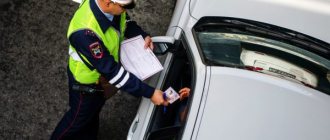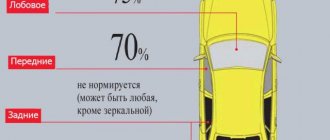What is considered dangerous driving?
The legislator described dangerous driving in paragraph 2.7 of the traffic rules. It includes six main violations.
Do not give way when changing lanes. The driver changes lanes into the adjacent lane and creates interference for those already driving in it - they are forced to brake sharply, and there is a threat of an accident.
Change from lane to lane. This is prohibited during heavy traffic, that is, in a traffic jam. When all lanes are occupied, you can only change lanes to turn, make a U-turn, stop, or avoid an obstacle, such as cars that have stopped due to an accident.
Don't keep your distance. The driver is too close to the car that is driving in front of him. By law, he is required to maintain a distance that will allow him to avoid crashing during sudden braking.
Drive between the rows. The lateral interval is often not observed by motorcyclists who ride between cars.
Brake sharply. Automobile drivers sometimes overtake a car, and then brake sharply in front of it. According to the rules, a driver can only brake like this if he is trying to prevent an accident.
Interfering with overtaking. A bad driver may not allow himself to be overtaken. To do this, he increases his speed when another car is ahead of him in the adjacent lane. If the road is two-lane and the other driver is driving in the opposite direction, this behavior can lead to a head-on collision.
These situations are considered dangerous driving if the driver commits more than two violations in a row and creates a risk of an accident.
Definition
Dangerous driving is a set of actions by a motorist that were performed within a short period of time and threatened the safety of other road users.
These actions could be:
- Failure to comply with the requirements to give way to a vehicle having the right of way when changing lanes.
- Changing lanes in the presence of heavy traffic, i.e. when all lanes are occupied by cars. The exception is turning, turning around, stopping or going around an obstacle.
- Failure to maintain a safe distance from the vehicle ahead.
- Failure to maintain lateral spacing between vehicles.
- Sharp braking. The exception is cases when it was necessary to brake in order to prevent an accident.
- Intentional obstruction of overtaking, if it created a threat to the safety of other road users.
- Intentional damage to vehicles, structures, cargo and other road users or causing material damage to them.
Thus, it is dangerous driving that results from collisions with pedestrians who are standing at a stop waiting for transport, to move to the side of the road or to a pedestrian crossing.
According to statistics, on average about 10,000 people die from dangerous driving and almost the same number of people end up in hospital with serious injuries.
In connection with the introduction of the term “dangerous driving” into legislation, the following categories of citizens become such drivers:
- motorcyclists;
- a driver who stopped and turned on a warning triangle after being blinded by an oncoming car;
- a person who drove around an obstacle on the road and changed several lanes;
- a driver changing lanes from the far left to the far right lane on a motorway.
What are the criteria for dangerous driving?
Each of these violations by itself does not mean dangerous driving. To classify aggressive driver behavior, two additional conditions were introduced.
More than two violations in a row. The driver must break the rule several times one after another. The frequency with which violations must occur is not specified in the law. According to legislators, this creates a danger for other road users: they cannot predict the driver’s behavior and react adequately to avoid an accident.
Threat of an accident. Another prerequisite for dangerous driving is that the driver creates a situation in which other road users are forced to change direction and speed, otherwise they risk getting into an accident.
What is the fine and for what?
Since 2021, the traffic police has been seeking to have a new article 12.38 on dangerous driving introduced into the Code of Administrative Offences. In this case, a fine of 5,000 rubles will be imposed for aggressive behavior on the road. The bill on the new fine passed the first reading in the State Duma, but has not yet been adopted.
Daria Ponomareva, forensic expert-autotechnician "Auto MFC" Before the bill is adopted, it must go through a global approval procedure in different authorities and departments. Meetings on the bill were repeatedly postponed because expert opinion on the issue was needed.
The Administrative Code already contains penalties for certain violations:
- change lanes and do not give way to a car in this lane - 500 rubles under Part 3 of Art. 12.14 Code of Administrative Offences;
- violate the rules for positioning a car on the road: change lanes in a traffic jam, do not maintain distance and lateral intervals between cars, brake sharply, prevent overtaking - 1,500 rubles under Part 1 of Art. 12.15 Code of Administrative Offences.
By law, these fines can be paid with a 50% discount if you manage to do this in the first 20 days.
How the traffic police proves dangerous driving
Under the presumption of innocence, the driver is not required to prove that he has violated anything. This must be done by traffic police officers. The exception is when the violation was caught on a video camera. Cases of dangerous driving cannot be photographed, so the traffic police proves them in the usual way.
Protocol. The inspector stops the violator and draws up a protocol to record the violation. A copy remains in the hands of the driver.
Resolution. Later, the traffic police, together with the driver or in his absence, conducts an analysis. Based on the results, the traffic police sends the driver a decision on an administrative violation. It arrives by mail, but not always - it’s better to check your fines.
How to dispute. If the driver does not agree with the decision, he can file a complaint addressed to the head of the traffic police department that issued the fine. The application can be sent through the traffic police website, on the application acceptance page. There are 10 days for this from the date of the decision. Another option is to file a complaint in court.
Responsibility for dangerous driving may be imposed until the end of the year
At the beginning of 2021, a bill imposing a fine of 5,000 rubles for violating norm 2.7 of the Rules was already adopted by the State Duma in the first reading. It is expected that the second reading, which will take place at the end of November, will enshrine this sanction in the Code of Administrative Violations in the new Article 12.38, however, this measure may not be the only one.
"Dangerous driving" is a driver's repeated behavior of violating traffic rules that results in a traffic hazard and a risk of death or injury. First of all, this applies to failure to comply with the requirement to give way, changing lanes during heavy traffic, failure to maintain a safe distance from the vehicle in front, failure to maintain a lateral interval, sudden braking and obstruction of overtaking. How will “dangerous driving” be assessed and punished after Article 12.38 is added to the Administrative Code?
This issue has been discussed among experts for a long time. Last spring, a wide discussion of “dangerous driving” took place in the Open Government format, where, during public hearings, a number of additions to the traffic rules were formed, which were implemented on June 7, 2016 in the form of adding a ban on dangerous driving to paragraph 2.7 of the traffic rules.
Photo: traffic police
“Now we can say quite firmly that society understands what is happening on the roads and how road traffic can be life-threatening,” says the president of the expert group, Natalya Agre, citing the results of surveys conducted on the traffic police website. — In recent years, a lot of social work has been done to explain all aspects of aggressive driving, and this is yielding results. Society is against aggressive driving. In general, about 70% of drivers spoke on the website in support of introducing a definition of dangerous driving in traffic rules, and we believe that the responsibility that will be recorded in the Administrative Code in the near future should be sufficient to ensure that drivers with deviant behavior do not even have the desire to get out on the road."
However, the issue of punishment for dangerous driving is still controversial. Some social activists believe that administrative punishment for reckless drivers is not enough. This opinion, for example, is shared by the editor of the Za Rulem magazine, Sergei Smirnov, who considers the fine for dangerous driving in the amount of 5 thousand rubles, approved in the first reading, to be “reform for the sake of reform”: “Dangerous driving in the wording given in the Rules is driving when there is a threat to life or health. A fine of five thousand rubles for such a violation is reform for the sake of reform. The punishment for a serious violation must also be serious. At a minimum, deprivation of rights. Or maybe criminal liability. Those violators who commit such a violation will calmly pay a fine. This won't stop them. And then only if they are caught.”
The absence of inevitability of punishment or the imposed light punishment for “dangerous driving” will not change the situation on the roads, Sergei Smirnov believes. But the Chairman of the Public Council of the Ministry of Transport of the Russian Federation, Director of the Institute of Transport Economics of the Higher School of Economics, Mikhail Blinkin, at a meeting on “dangerous driving”, said that following the example of Great Britain, where dangerous driving is punishable by criminal liability up to two years in prison, is premature in Russia: in the United Kingdom, this practice has been refined over the years. “We are definitely not ready for this yet,” sums up the influential expert.
Among the opponents of criminal liability is the First Deputy Prime Minister of the Russian Government, Igor Shuvalov, who believes that it is necessary to properly determine administrative liability. “It can be very serious and tough, but it is still an administrative responsibility,” says the civil servant.
The option of “serious and tough” responsibility was proposed by Maxim Liksutov, Deputy Mayor of Moscow for Transport and Development of Road Transport Infrastructure in Moscow. “Analysis of traffic accidents shows that 80% of dangerous driving cases result in death. Therefore, we believe that the social aspect here is extremely high, and the risks that these violators create are extremely high. We propose to give traffic police officers the right to revoke the right to drive a vehicle on the spot for a period of at least 6 months. And second. It is necessary to increase penalties for the driver. And tie the size of the fine to the cost of the car. Determining this cost is quite simple: it is either through CASCO, or through those directories used by customs authorities.”
Photo: traffic police/Shutterstock
In addition to the problem of punishment for dangerous driving, the State Duma will also have to approve the evidence base that will be considered legitimate in legal proceedings. Minister of Communications of the Russian Federation Nikolai Nikiforov believes that the solution proposed today in the form of video recording is not reliable and cannot fully prove the fact of a violation.
“On the one hand, residents of the Russian Federation have in their hands about 60-70 types of different smartphones, which are complex computing devices and can shoot video in high quality, providing geolocation and a guarantee that this material has not been changed. On the other hand, there are a large number of different DVRs installed directly in cars that do not have such a set of functions. Whatever materials are provided in the courts, employees of the direct management of the traffic police in the regions will have to defend the legitimacy and legal evidence of the digital database that was presented in administrative and, especially, criminal cases. I believe that at the initial stage we are definitely ready to use materials where we can accurately identify the author of this submission, where we can clearly identify the place where this violation occurred - dangerous driving or a specific violation of traffic rules, and we can guarantee the immutability of these materials. Today we are completely ready to do this on the basis of smartphones. But the answer to the question of whether we can use all the data from DVRs in order to legitimately bring to justice, the answer is most likely no.”
As a solution to this problem, Nikiforov proposes to develop devices that include additional functions necessary for recording offenses, but Shuvalov sees this as an opportunity to monopolize the market for such devices and advises simplifying the approach to this issue. In addition, to simplify drivers’ understanding of the very wording of “Dangerous Driving” and options for influencing violators, Shuvalov, at the Public Discussion, initiated the creation of an Internet resource with video recordings of examples of dangerous driving and receiving comments from citizens - dangerous driving.rf, and drew attention to the experience of “folk inspectors" of Tatarstan - users of the "People's Inspector" system, which in 2021 helped the regional authorities impose about 37,000 fines worth 48.9 million rubles.
The launch of the People's Inspector application on the territory of the Russian Federation was discussed at a Government meeting on October 5. Most experts supported this idea with the caveat that for the correct operation of this system, it is necessary to provide the appropriate infrastructure. “The government plans to spend more than 2.5 billion rubles over 3 years to create this infrastructure. But taking into account the fact that the “people’s inspector” will, among other things, help collect fines, this will partially compensate for the government’s costs,” says Mikhail Abyzov, Russian Minister for Open Government. It is planned that the application will be fully operational in a year, after the appropriate testing, which is currently taking place in Moscow and Kazan.
Photo: traffic police
The State Traffic Safety Inspectorate believes that thanks to citizens recording cases of dangerous driving, the number of bad drivers on the road today has decreased, however, work on the formation of an effective law must be continued and, at the second reading of the bill, the terminology, fines and responsibility of drivers who use “dangerous driving” must be finally determined.
“My colleagues and I will work on this and further ensure that the traffic police inspector can apply the new provisions of the Code of Administrative Offenses correctly and without unnecessary conflicts with road users,” says Major General of Police Mikhail Chernikov, head of the Main Directorate for Road Safety of the Ministry of Internal Affairs of Russia. . “But administrative influence is only one of the components of prevention. The most important thing, in my opinion, is to convince road users that they are not alone on the road and both their own lives and the lives of the people around them depend on their behavior.”
Let us remind you that the text of the bill “On Amendments to the Code of the Russian Federation on Administrative Offenses in terms of establishing administrative liability for dangerous driving” and the materials for it can now be found on the official website of the State Duma of the Russian Federation.
The material was prepared within the framework of the Federal Target Program “Improving Road Safety in 2013-2020.”
Remember
- Dangerous driving under the law is when a driver violates the rules of maneuvering and changing lanes more than two times in a row, thereby creating a risk of an accident.
- There is no fine for dangerous driving, but there is a fine for improper lane changing and maneuvering, from 500 to 1,500 rubles.
- These fines can be paid with a 50% discount in the first 20 days.
- Such violations are not recorded by cameras. The inspector must stop the violator, draw up a report, and later the traffic police will send a resolution.
- If you do not agree with the violation, you can appeal it - to the traffic police or through the court.
All articles by the author: Ilya Novikov
How to avoid paying a fine
There are several options to try to avoid punishment if you are charged with aggressive or dangerous driving.
According to the law, punishment does not apply if:
- the violation was committed by a person with disabilities. This includes drivers with the first or second group of disabilities;
- the violator is a pregnant woman, that is, a pregnant woman, as well as a woman who has a minor child;
- the violator is a citizen who has been called to training camp or is a military serviceman;
- the offender has a special rank. This includes employees of internal affairs bodies, as well as representatives of the penal system;
- the offender is under 18 years of age, that is, in fact he is a minor.
If citizens belonging to this category have committed an offense that provides for liability under the article on dangerous driving in a more severe form than a fine, they can achieve a reduction in the penalty. For example, arrest can be replaced by payment of a fine. But then the amount of the fine will exceed the standard amount regulated by law in the amount of 5 thousand rubles.
Now as for ordinary motorists who do not have any privileges. They should understand that the fine for a vehicle will not be issued by the inspector who stopped you, but by the head of the traffic police on the basis of a prepared report.
In such a situation, the only way to prove innocence is to try to convince the inspector that the driver performed all his actions with a single purpose. Namely, for the sake of preventing a possible accident.
If the driver is deeply convinced that he is right and is ready to defend his position to the end, it makes sense to turn to lawyers. They will help collect evidence and also challenge the sentencing decision.










